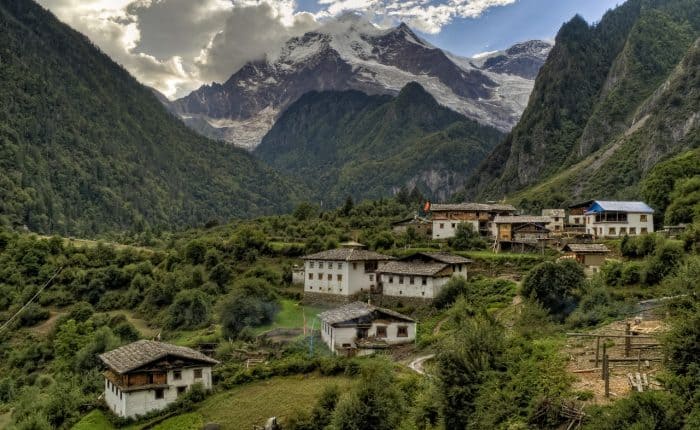Business And Employment Opportunities In The Himalayan Highlands Of India
In spite of its tourist appeal, much of this area is undeveloped and unexplored. Protectionist measures by the Indian government have kept most of the land limited to agricultural use. So land with breathtaking views is still available at low prices, and the tourism potential of the area is largely untapped.
The region is visited by over 250,000 Indian tourists and 80,000 foreign tourists each year. The potential for winter sports and adventure tourism is being capitalized on only at a very basic level by the local population, in spite of the fact that the valley is home to no less than five individuals who’ve climbed Mt. Everest (and lived to tell the tale).
In contrast to the almost complete lack of locally organized skiing business, an Australian adventurer and inventor, Roddy McKenzie (also an Everest veteran), has built over the last 10 years a highly profitable Heli-skiing operation based in Manali.
Roddy’s company, Himachal Heli-Skiing, attracts customers from around the globe who pay $8000 a week each to ski the powder snow of the Himalayas and be ferried up the ski-lift-barren slopes in helicopters by Swiss pilots.
Quality Of Life In The Himalayas
A similar situation exists with regard to hotels, restaurants, bars, and cybercafes. Though there’s no shortage of any of these, there’s a distinct lack of quality in most.
The establishments that really seem to know what they’re doing are invariably run by foreigners who’ve settled here and do a brisk business in the absence of serious competition. With very little investment, you could own a profitable restaurant or bar.
A few expats have started restaurants that only operate on one day of the week and offer continental favorites. Pizzas made to order in wood-burning ovens, schnitzel, rösti, pasta, smoked trout with fresh garden-grown lettuce, and of-course, chilled beer.
Wines are not easily available save a few local apple wines. One of the expat settlers, a professor of mathematics from Canada, has a wine cellar in the basement of his house. He shares his collection with friends and family and occasionally sells some to other expats.
Business In The Himalayas
Outsiders are not allowed to buy land here. Only bonafide Himachali agriculturists can own land. But there are ways around this, similar to the concept of titulars in Andorra. To run a business, the easiest would be to lease a suitable property.
Seasonal
The business here is seasonal. Which is great, the summers are the best time anyway. Many expats live half the year in the Himalayas and half in Goa, running profitable businesses in both places and enjoying the good life at rock-bottom prices.
The “off-season”, from about November to March, isn’t completely dead, as it sees a steady flow of winter sports enthusiasts, as well as a rush around Christmas.
Untapped Potentials
There are a number of other businesses that come to mind when one thinks of exploiting the untapped potential of this area. A friend of ours grows orchids.
The local weaving industry produces excellent products when guided by someone who understands the global market. Hand-woven shawls made from pashmina, yak wool, merino wool, or Angora rabbit wool are fantastic. You can have the finest pashminas custom woven to your specifications.
Labour
Labour is still cheap here and it’s easy to find people who are eager to learn, work, and raise their standards of living. Roddy is capitalizing on the cheap labor by manufacturing avalanche bags of his own design, specially adapted to the extreme conditions of the Himalayas.
The local boys who work for him manufacture the most advanced avalanche bags in the world, right here in a little workshop next door to a small local cafe.
The “Charas” Trade
The locals welcome new business and Manali has grown over the last ten years from a small, boring, hippie hang out with only a thriving ‘charas’ economy to a busy tourist destination where the glitterati come to go heli-skiing and shoot movies in the Himalayas.
The ‘charas’ (hand-rubbed Hashish), which this area is famous for, isn’t as cheap as it was 10 years ago, but by Western standards, it’s still a steal. A lot of people in the valley smoke charas, and it is easily available, though it’s not at all a good idea to be caught carrying any, especially if you’re a foreigner.
The charas trade here isn’t violent at all. No territory battles and loud noises in the night. The trade provides employment to thousands of locals who rub the resin out of the buds of the hemp plant, which grows wild all over the mountains and on the sides of the roads.
In the market, one can find slippers, bags, and mats woven by local women out of hemp fiber. Nevertheless, the authorities regularly go around destroying hemp plants and seizing vast quantities of charas from farmers and couriers.
Conclusion
Here is probably the most extensive ebook on Everything You Ever Wanted To Know About Eliminating Your Taxes, Protecting Your Assets And Regaining Privacy Over Your Life And Investments. It is called The Ultimate Guide To Going Offshore.
I hope you enjoyed reading this article: Business And Employment Opportunities In The Himalayan Highlands Of India. If you have any questions, please contact our office HERE.
I’ve included some great articles for you to read, enjoy!
Your Dream Vacation In The Himalayas
Top 7 Adventure Travel Places In India
Excerpted from “Living In The Valley Of Gods: Life In The Himalayan Highlands” in Escape From America Magazine, Issue 55.
Like Our Articles?
Then make sure to check out our Bookstore... we have titles packed full of premium offshore intel. Instant Download - Print off for your private library before the government demands we take these down!






